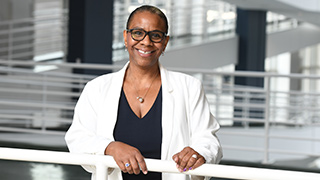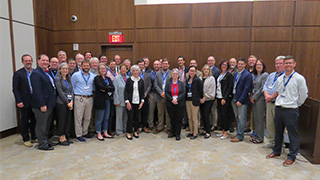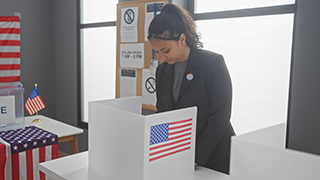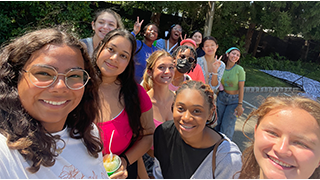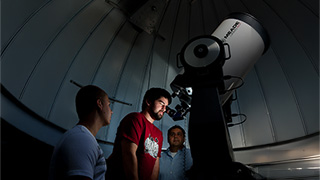Final Exam for Military Strategy Course Challenges Students in Crisis Simulation
Thursday, June 6, 2024
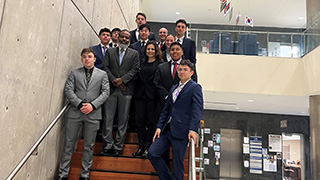
Students and faculty of Military Strategy for Diplomats course 2024.
Students in LTC Adam Scher's Military Strategy for Diplomats course at Seton Hall University tossed their blue books to the side for a more unique final exam this spring: a dynamic crisis simulation as the United States National Security Council.
On Wednesday, May 8, instead of their standard lecture room in Mooney Hall, Cadets and Diplomacy students took seats in a conference room in Jubilee Hall. They were joined by distinguished guests, including Professor Barbara Callahan and Dean Elizabeth Halpin from the Buccino Leadership Institute, Dean Courtney Smith from the School of Diplomacy, and Marvin Walker, J.D., dean of the College of Professional Studies at New Jersey City University, who had the pleasure of playing the president in the simulation.
The National Security Council (NSC) is a forum used by the President of the United States for considering national security and foreign policy matters with senior national security advisors and Cabinet officials. The NSC is a key part of the President's decision-making process on critical issues affecting the nation's security.
Students were given roles and a crisis scenario and had to write policy memorandums to explain their recommendations to the president. On May 8, they had two hours to complete a meeting to finalize their course of action with ‘President Walker.’ Students were graded based on their ability to convince the president to pursue their policy recommendations, creating a competitive drive to come to the meeting prepared and informed.
The crisis scenario involved a cyberattack on the Nasdaq Stock Market by the Chinese hacker group Zheng He Squadron, amidst rising tensions in the South China Sea. The cyberattack disrupted trading, causing significant economic damage and eroding confidence in the U.S. financial system. U.S. intelligence agencies assessed with high certainty that the attack occurred with the knowledge or support of parts of the Chinese government, although Beijing denied any involvement.
Prior to the simulation, students were given two weeks to study their crisis situation and roles. They had to create a two-page policy memorandum listing their recommended solutions and organize the meeting itself. The National Security Advisor (APNSA) was graded and tasked with organizing the meeting and outlining which topics from the other participants would make it into the meeting. The professor had no direct control, putting trust in the students to take what they had learned in class and apply it on their own for a grade.
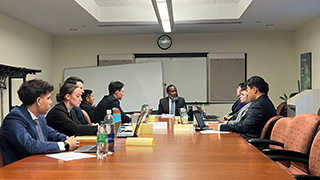
Students listened, spoke, and deliberated around the President, Marvin Walker.
Lieutenant Colonel Scher’s students came from a mix of Seton Hall Pirate Battalion ROTC Cadets and students from the School of Diplomacy. Students found themselves challenged, as military students were given civilian roles in the simulation, and the civilians found themselves representing the Department of Defense. To succeed, students had to step out of their comfort zones and expand their worldviews.
Students found that once the positions were understood, no matter what background they came from, the policies they represented carried their own voices. Marvin Walker, a man with genuine experience in the NSC, said that the students uncannily acted out the simulation just as it would have in real life, with the exception that the real advisors would have used swear words.
The students came well-prepared with a litany of solutions and a fully booked schedule, yet immediately faced challenges upon commencing the simulation. LTC Scher began implementing dynamic crisis updates, forcing students to adapt their strategies to a changing situation.
"I was extremely impressed with their critical thinking and ability to adapt as facts and circumstances constantly changed throughout the exercise", Buccino’s Professor Callahan words reflected the weight preparation had on the success of the simulation.

After the Simulation, participants and observers alike shared their thoughts.
As the National Security Council deliberated and debated their plans, they realized that while they were advocating for their own solutions, they were still teammates. To solve the issue effectively, the inter agency process required everyone's resources to be used in tandem. The students with the best grades found themselves to be the most influential in combining resources and being team players.
"It was interesting to see how through discourse some actions were quickly shutdown, modified, or ended up as the focal points of discussion" were the words of Qing Leasure, ROTC Cadet and Diplomacy student, who got the highest grade as the US Ambassador to the UN.
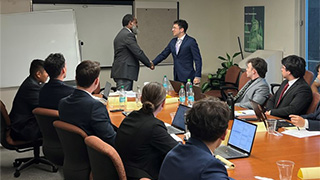
National Security Advisor CDT Mastroserio handing Marvin Walker a Pirate Battalion Challenge Coin.
As the year closes, the students who took this class all agree that the experience given by this course was both unique and invaluable. There is hopeful anticipation among cadets, students, and faculty about the possibility of continuing this distinctive learning opportunity for future students next spring. Gabriella Fernandez, diplomacy student and member of the Buccino leadership institute, said it best:
"What I learned from this experience and class as a whole was some of the most valuable, practical information I’ve gained from my academic experience at Seton Hall so far."
Categories: Campus Life

